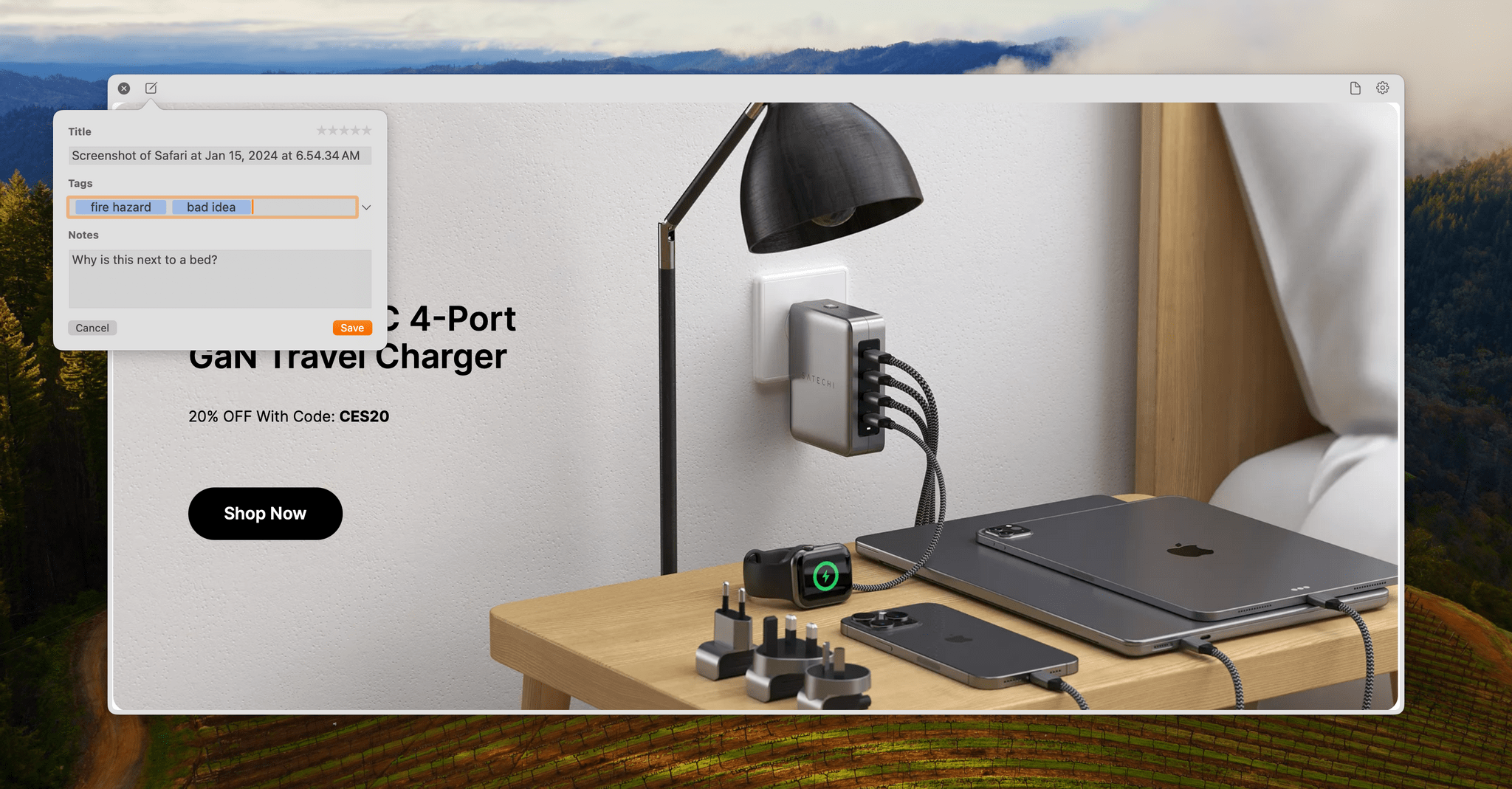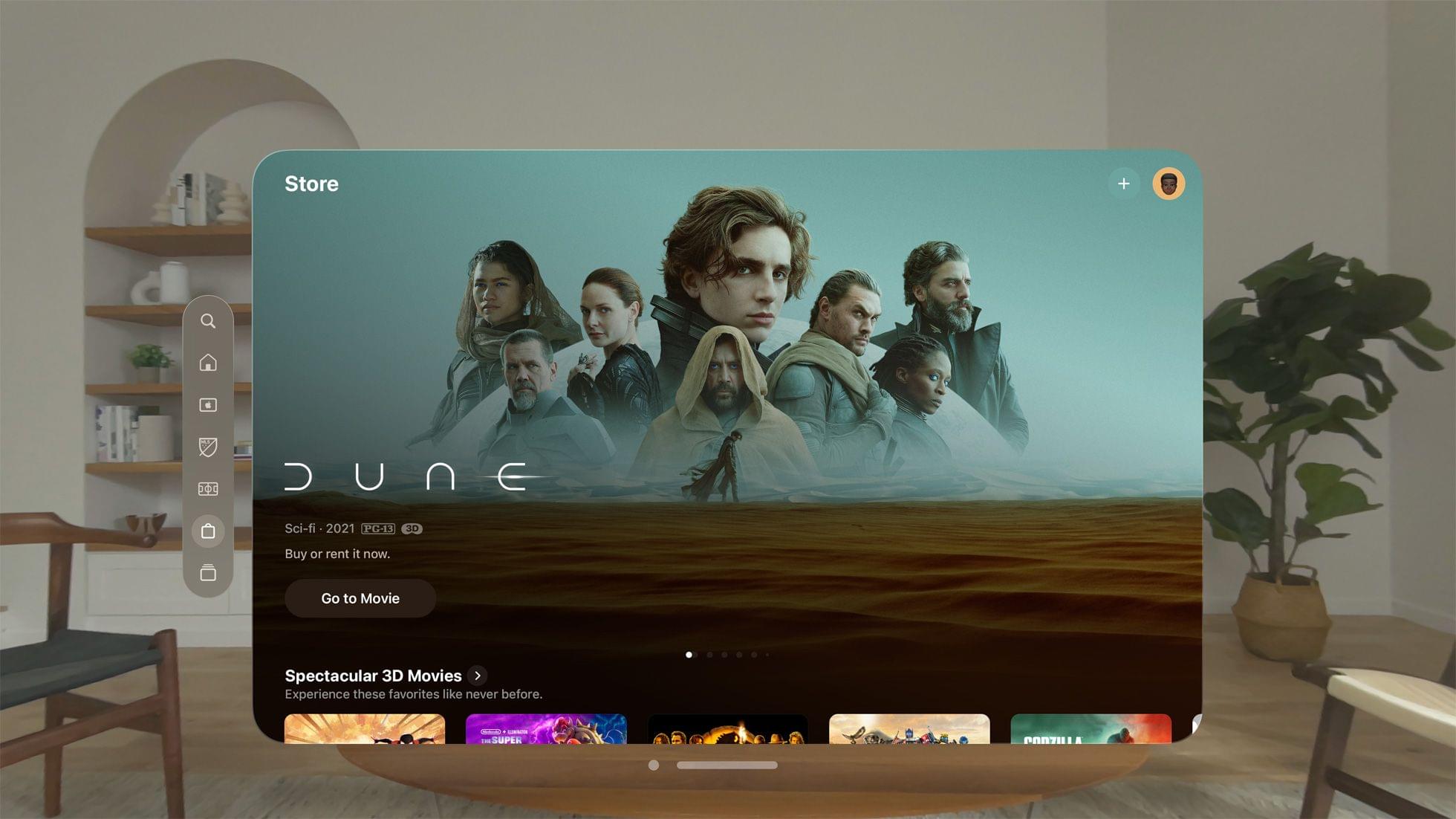ScreenFloat 2.0 is a Mac-only screenshot utility from Matthias Gansrigler of Eternal Storms Software. As Gansrigler explains, the app is like Picture-in-Picture for screenshots, allowing you to float screenshots or screen recordings above other windows to use as reference material on your Mac. That’s a great explanation of one of the core use cases for ScreenFloat 2.0, but the update opens up exciting new possibilities that go even further, which I think anyone who works with screenshots will like a lot.
ScreenFloat 2.0: Floating Reference Screenshots and Management from the Mac’s Menu Bar
New Apple Vision Pro Hands-On Accounts From Engadget and The Verge
Today’s announcement by Apple about the entertainment aspects of the Vision Pro was followed up by new hands-on stories from Engadget and The Verge. A lot of what they saw was similar to the WWDC demos, but there were some new highlights, including additional Environments, a beta of the Disney+ app, Apple’s Encounter Dinosaurs app, and the Vision Pro’s floating keyboard.
One of the big open questions about the Apple Vision Pro is how well its virtual keyboard works. Interestingly, Engadget’s Cherlynn Low and Dana Wollman had very different experiences with it:
Cherlynn: It’s not as easy as typing on an actual keyboard would be, but I was quite tickled by the fact that it worked. Kudos to Apple’s eye- and hand-tracking systems, because they were able to detect what I was looking at or aiming for most of the time. My main issue with the keyboard was that it felt a little too far away and I needed to stretch if I wanted to press the buttons myself….
Dana: This was one of the more frustrating aspects of the demo for me. Although there were several typing options – hunting and pecking with your fingers, using eye control to select keys, or just using Siri – none of them felt adequate for anything resembling extended use. It took several tries for me to even spell Engadget correctly in the Safari demo.
Engadget’s editors were also impressed with the Disney+ Avengers and Star Wars-themed environments.
The Verge’s Victoria Song and Editor-in-Chief Nilay Patel also spent some time with the Apple Vision Pro. According to Song’s story:
Nilay had shot some spatial videos where he’d intentionally moved the camera to follow his kid around the zoo and felt some familiar VR motion queasiness. Apple says it’s doing everything it can to reduce that, but it’s clear some shots will work better in spatial than others — like any other camera system, really.
Song describes the experience of seeing EyeSight demoed, too:
So we got to see a demo of EyeSight — what an onlooker would see on that front display when looking at someone wearing the Vision Pro. It’s a bit goofy, but you can see the wearer’s eyes, part of what Apple calls a “persona.” (We were not able to set up our own personas, sadly.) When Apple’s Vision Pro demo person blinked, we saw a virtual version of their eyes blink. When they were looking at an app, a bluish light appeared to indicate their attention was elsewhere. And when they went into a full virtual environment, the screen turned into an opaque shimmer. If you started talking to them while they were watching a movie, their virtual ghost eyes would appear before you. And when they took a spatial photo, you’d see the screen flash like a shutter.
What’s clear is that it’s one thing to read about these experiences with the Vision Pro and a completely different thing to live them. After reading several accounts, I still don’t know what to expect myself, except in the broadest sense. That’s both a little frustrating but also very exciting.
Apple Details Vision Pro’s Launch Day Entertainment Options
Apple has revealed new information about the entertainment that will be available when Vision Pro launches on February 2nd.
One of the highlights will be 3D movies. There will be more than 150 3D movies available, including Avatar: The Way of Water, Dune, Spider-Man: Into the Spider-Verse, and The Super Mario Bros. Movie, all of which can be watched from a simulated personal theater environment or immersive Environments, including Yosemite, Haleakalā, and Mount Hood. Also, Apple Vision Pro users who already own a movie for which a 3D version becomes available will have access to it at no additional cost. Apple says streamers like Disney+ will offer 3D movies as part of their services, too.
Those same streaming services will also offer other unique experiences. For example:
With Disney+, subscribers can watch thousands of TV shows and films from four iconic environments with vivid details: the Disney+ Theater, inspired by the historic El Capitan Theatre in Hollywood; the Scare Floor from Pixar’s Monsters Inc.; Marvel’s Avengers Tower overlooking downtown Manhattan; and the cockpit of Luke Skywalker’s landspeeder, facing a binary sunset on the planet Tatooine from the Star Wars galaxy.
Tom Coates on Integrating Threads with the Fediverse→
Just before the holidays, Meta held a meeting at its San Francisco offices with members from the fediverse community about its plans to use ActivityPub to integrate Threads with Mastodon. Last week, Tom Coates wrote a detailed post about everything covered during the meeting from Meta’s roadmap for Threads to Meta’s motivations, content moderation, and Threads’ algorithm, which is lengthy but well worth reading in its entirety.
Coates described Threads’ roadmap as follows:
- December 2023 – A user will be able to opt in via the Threads app to have their posts visible to Mastodon clients. People would be able to reply and like those posts using their Mastodon clients, but those replies and likes would not be visible within the Threads application. Threads users would not be able to follow or see posts published across Mastodon servers, or reply to them or like then.
Early 2024 (Part One) – the Like counts on the Threads app would combine likes from Mastodon and Threads users
Early 2024 (Part Two) – replies posted on Mastodon servers would be visible in the Threads application
Late 2024 – A “mixed” Fediverse and Threads experience where you will be able to follow Mastodon users within Threads, and reply to them and like them
TBD – Full blended interoperability between Threads and Mastodon
The schedule struck Coates as both optimistic given the complexities involved and likely to be controversial because the early stages are lopsided in favor of integrating Threads into Mastodon and not the other way around. As Coates explains, there are technical, legal, and regulatory reasons for that, but that won’t make it any less contentious.
Scale is quite literally another huge problem for Meta that could easily lead to unintended consequences that cause problems for Mastodon users no matter what Meta’s intentions are. As Coates explains:
The community that Threads is planning to participate in is that of Mastodon servers federating with one another via Activity Pub. The estimates of this community are that there are about 9,500 separate mastodon instances participating in this ecology, with roughly 1.5 million Monthly Active Users (MAUs). This is a fairly substantial number but of course it pales in comparison to Meta more generally, which has closer to three billion active users. Or to put it another way, Mastodon users represent about 1/2000th of the number of people using Facebook/Instagram/Threads/WhatsApp etc. worldwide.
Threads itself has only been around for a few months now and it still towers over the rest of the Mastodon community in terms of users. It’s based on the Instagram user base, and Instagram users can opt in to use Threads with a single tap. Because of that—as of a recent earnings report—Meta can currently claim around 160 million total users and about 100 million MAUs for Threads alone. So, again, maybe we shouldn’t be thinking about Threads ‘integrating’ with the fediverse and instead think about Threads attempting to engage with the Fediverse without entirely crushing it in the process.
The entire post is worth reading because it explores interesting ways to deal with distributed content moderation, identity, public education about federation, and all the other large-scale problems that Threads will bring with it into the fediverse by virtue of its size and commercial goals as an ad-funded company. None of these issues will be easy to solve, and the meeting happened before an upturn in objectionable content served by the Threads algorithm to many users. However, I’m still encouraged by Coates’ overall reaction to the meeting and the teams at Meta who are working on integrating Threads with the Fediverse:
But I can report that in my opinion the teams building it and the integration seem to be decent people, trying to build something they’re excited by, wanting to be part of something new and truly federated, and wanting to be respectful and careful about how they do it. And whether or not you think their arrival in the space is a good thing, that apparent good faith and care has mitigated at least some of my concerns.
AppStories, Episode 366 – Magic Rays of Light Joins MacStories, Plus Our Favorite Media Tracking Apps→
This week on AppStories, we are joined by Sigmund Judge and Devon Dundee, the hosts of Magic Rays of Light, a weekly show that explores the world of Apple TV and Apple Arcade, which has joined MacStories, to discuss the show’s move to MacStories as well as tvOS and the apps we use to track media.
Sponsored by:
- Memberful – Easy-to-Use Reliable Membership Software
On AppStories+, Federico shares tips on how he’s worked around some of the limitations of Apple Podcasts’ queueing system.
We deliver AppStories+ to subscribers with bonus content, ad-free, and at a high bitrate early every week.
To learn more about the benefits included with an AppStories+ subscription, visit our Plans page, or read the AppStories+ FAQ.
We Are Bringing Magic Rays of Light, Our Podcast about Apple TV, to MacStories
Today is an exciting day for Magic Rays of Light. We couldn’t be happier that our show is joining the MacStories family of podcasts. Before the first episode of this new era releases on Wednesday, we thought we’d take a moment to introduce ourselves and the show to you.
You can subscribe to Magic Rays of Light using the buttons below:
Magic Rays of Light is a weekly podcast exploring the world of Apple TV hosted by Sigmund Judge and me, Devon Dundee. You may remember Sigmund from his tvOS 17 review last fall. He’s the founder of Apple TV-centric website Screen Times and has been covering the platform since 2015.
In July of 2020, Sigmund launched Magic Rays of Light as a biweekly podcast discussing Apple TV news and everything happening with the upstart Apple TV+ streaming service. Each episode featured a special guest co-host, with guests ranging from journalists to developers to Danny Rojas himself, Ted Lasso star Cristo Fernández.
As for me, I came across the podcast when it debuted and was immediately hooked. I’ve been a dedicated Apple TV user since I picked up a third-generation model in 2012 and have been blogging about my favorite shows and movies ever since.
I came aboard as co-host in May 2021, and since then, Sigmund and I have been covering everything Apple TV on a weekly basis together. Over the past 104 episodes, we’ve discussed updates to the Apple TV hardware line, software updates and new features, our favorite Apple Originals, and much more. We’ve brought on a wide array of guests to share their perspectives on Apple TV and had the opportunity to interview creative voices behind Apple Originals including Servant, Little America, and Severance.
It’s been a great run so far, and we’re thrilled to be taking this next step. MacStories is the perfect home for Magic Rays of Light and the topics that we discuss. We hope that our show will be an enjoyable supplement to the coverage you’ve already come to expect from the MacStories team.
The world of Apple TV is vast, and there’s so much to talk about:
- Hardware: The Apple TV isn’t on a regular update cycle, but Apple does love to surprise their TV fans with new hardware out of the blue. When each new iteration does come, we test it thoroughly and share every detail and addition, as well as our ideas of what we’d like to see come next. And of course, we have strong opinions on every single version of the Siri remote.
- Software: tvOS is a constantly-evolving platform with changes big and small coming year-round. We keep an eye on updates to share what’s coming next for Apple TV users. We also routinely share our own vision for the future of tvOS and highlight great third-party apps from the App Store.
- Apple Originals: Apple has become a major player in the worlds of streaming and TV/film production. Each week, we dive into new releases and round up all of the latest Apple Original news including production, development, casting, and awards.
- Games: We love to play games on the biggest screen in our homes, and Apple Arcade provides a continuous stream of new games to play. We highlight each new title as it arrives on the service and share what we’re playing in our downtime. With Apple’s continued push to bring top-tier games to its platforms, we’re always keeping an eye on new non-Arcade titles coming to the App Store, too.
- Apple Home: The Apple TV continues to play a central part in Apple’s smart home offering. In that vein, we keep up with the latest updates to the Home app and share our own smart home strategies with listeners. We also cover updates to the HomePod line and its integrations with Apple TV.
With so much going on, it’s an exciting time to be an Apple TV fan. We love exploring everything about it each week, and we’d be thrilled for you to join us! Magic Rays of Light makes its debut on MacStories this Wednesday. We can’t wait to talk to you then.
Magic Rays of Light Joins MacStories
We’re pleased to announce that starting today, Magic Rays of Light, the podcast hosted by Sigmund Judge and Devon Dundee is joining MacStories. Federico and I couldn’t be happier to be adding Sigmund and Devon’s expertise in all things Apple TV+, tvOS, and Apple Arcade to MacStories. It’s a fantastic show full of thoughtful insights on one of Apple’s most interesting platforms.
You can subscribe to Magic Rays of Light using the buttons below:
Whisper Memos: Turn Your Ramblings into Paragraphed Articles, Sent Right to Your Email Inbox [Sponsor]
Ideas are precious but fleeting. One moment, inspiration strikes, but if you don’t capture that lightning in a bottle, it’s gone before you know it. With Whisper Memos, you can harness the power of artificial intelligence to turn your ideas into orderly memos.
Whisper Memos combines the convenience of quick capture with the power of GPT-4. You can save a voice memo using your iPhone’s Action Button, the app’s Lock Screen widget, Whisper Memos’ Apple Watch app, Shortcuts, and more. Then, Whisper Memos uses AI to turn your recordings into orderly, paragraphed memos delivered directly to your email inbox a few seconds later.
The results are incredible. One moment, you’re recording audio on your iPhone or Apple Watch, and the next, you’ve got an email message easily identifiable by its custom subject line that has been carefully transcribed and organized into neat paragraphs.
Whisper Memos works on Wi-Fi, over a cellular connection, and offline, so it’s always available. The app also supports a long list of languages, and it integrates with Zapier, which allows you to connect Whisper Memos to other productivity apps like Notion, Trello, or your task manager. There’s even a privacy mode for ensuring no trace is left behind after your voice memos have been processed.
So, check out Whisper Memos today. You’ll be amazed at how fast, accurate, and reliable it is at preserving your precious thoughts.
Our thanks to Whisper Memos for sponsoring MacStories this week.
A Glimmer of Hope for Thread at CES→
Thread has a problem. It was supposed to be the low-energy, wireless protocol that lets all of your smart home devices talk to each other no matter who built them. However, in practice, devices from different makers don’t play very well with each other, often resulting in multiple Thread networks, largely defeating the purpose of the standard.
The good news is that Jennifer Pattison Touhy reports for The Verge that the Thread Group has a solution:
Thread Group’s plan to fix the multi-network problem is to standardize how border routers share credentials with border routers from different manufacturers. In a blog post released at CES this week, the group says these changes should make it easier to add a new Thread border router or Thread device to an existing network. The result will be “a single, larger ranging Thread mesh network, including multiple Border Routers, which in turn can increase the reliability of all the devices in it.”
That sounds great, but like any standard, it’s likely to take a while to filter through to the devices you use in your home. Still, it’s progress and a reason to be optimistic that eventually, your smart home devices may play nice with each other no matter who makes them.







](png/banneras-1629219199428.png)


